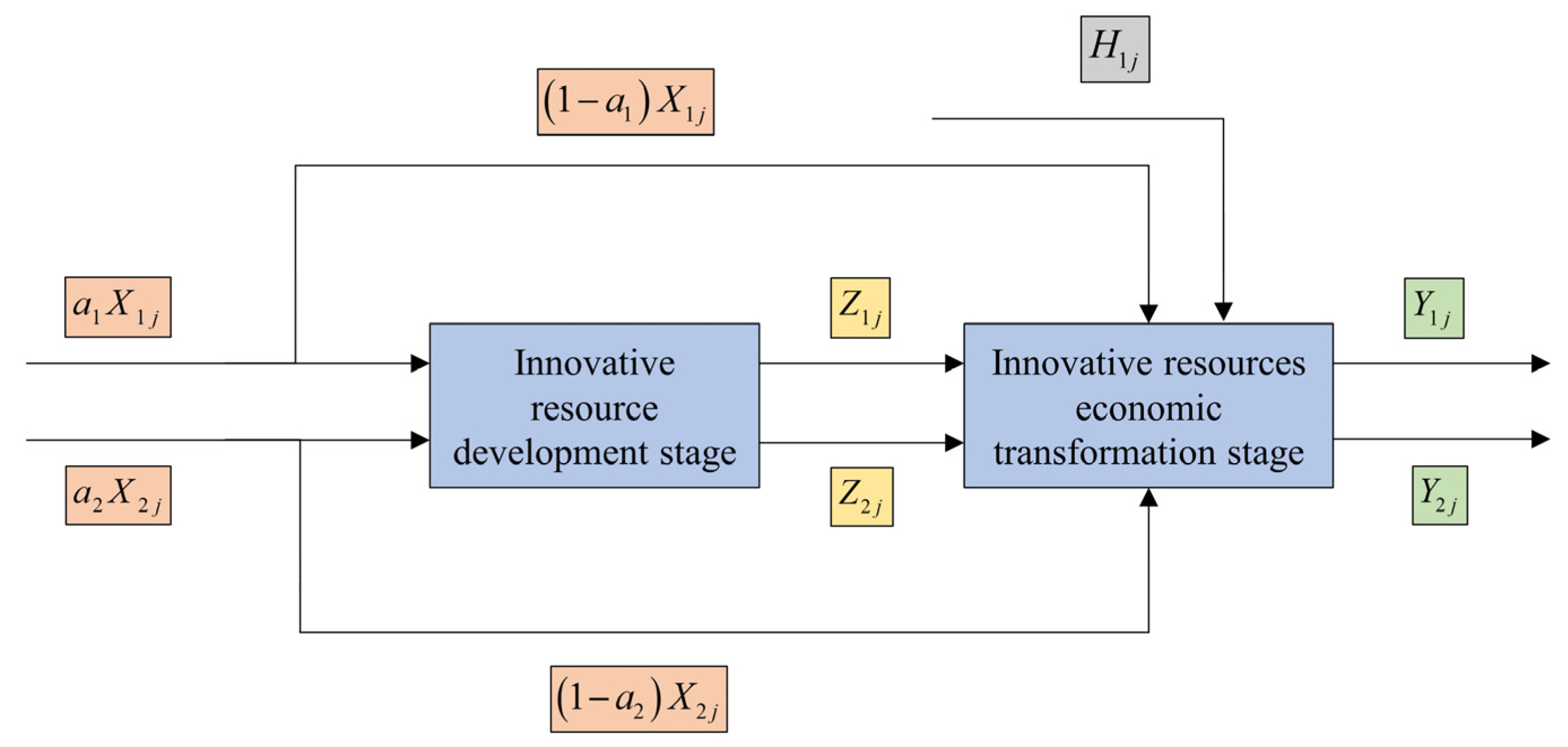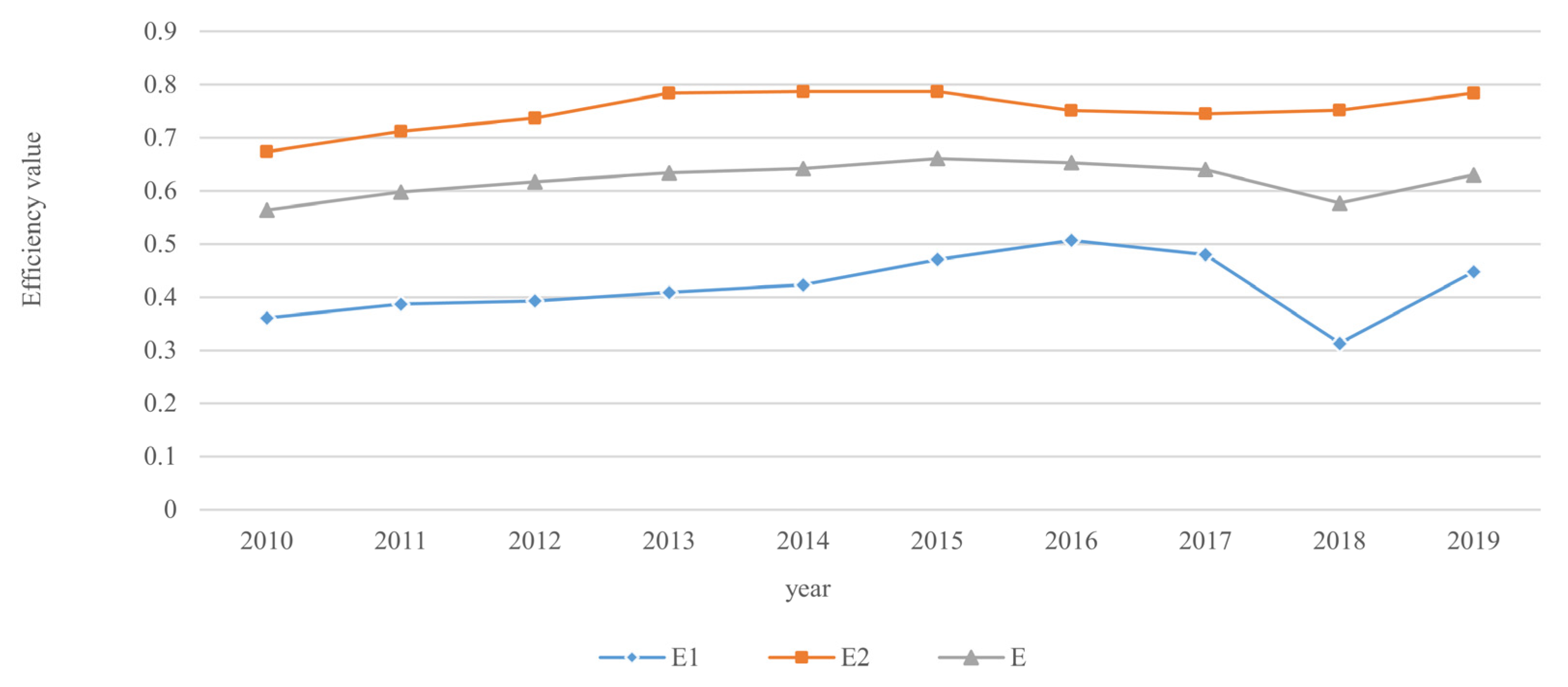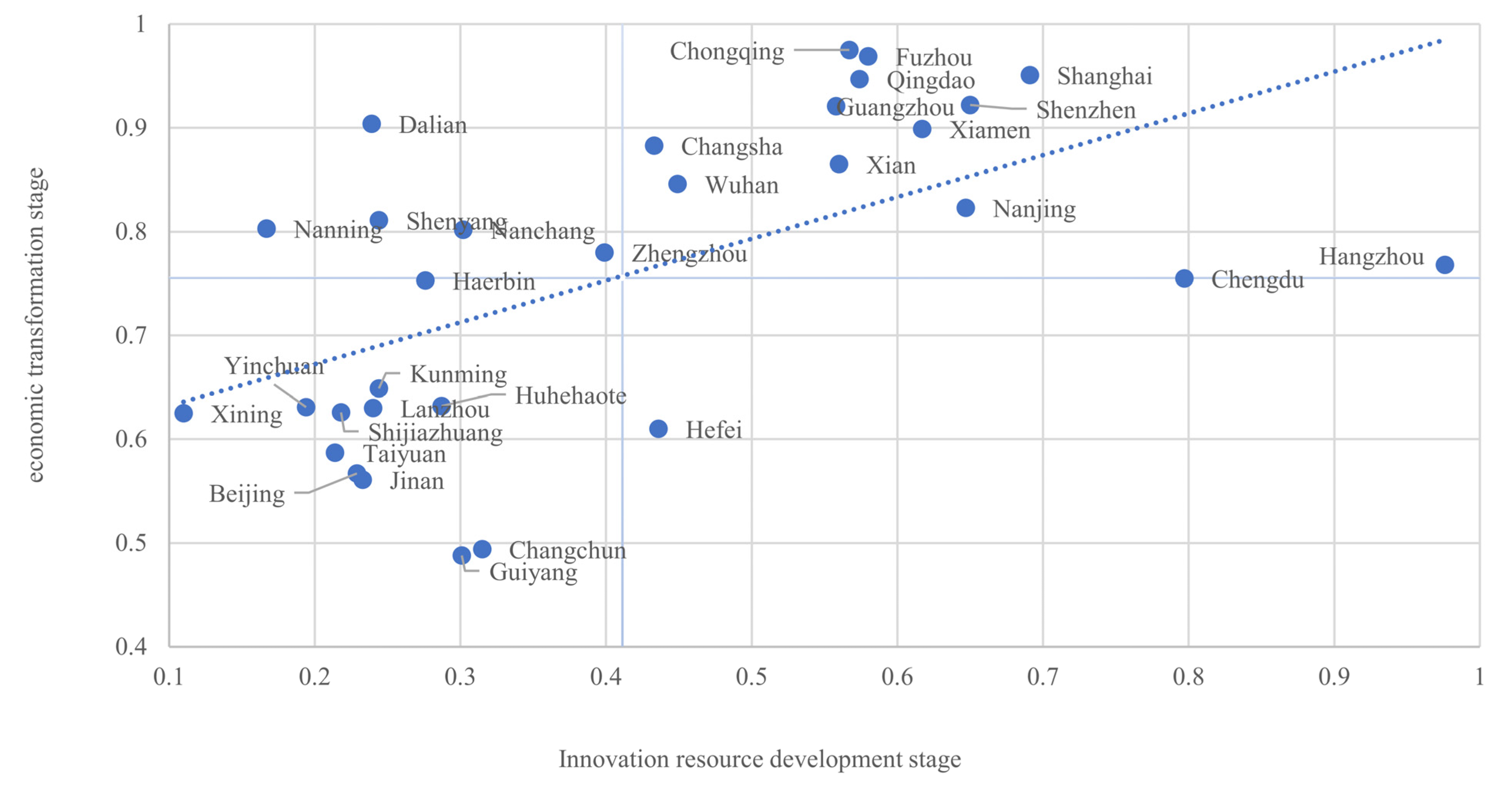Impact of Industrial Synergy on the Efficiency of Innovation Resource Allocation: Evidence from Chinese Metropolitan Areas
Abstract
1. Introduction
2. Theoretical Analysis and Research Hypotheses
3. Data Description and Research Methods
3.1. Measurements and Model Construction
3.1.1. Network DEA Model Based on Resource Sharing and Two-Stage Additional Input
3.1.2. Tobit Model
3.2. Variables
3.2.1. Explained Variable
3.2.2. Core Explanatory Variable
3.2.3. Control Variables
3.3. Research Sample and Data Sources
4. Results
4.1. Measurement Results
4.2. Aggregate Analysis
4.3. Regional Heterogeneity Analysis
5. Discussion
6. Conclusions
Author Contributions
Funding
Data Availability Statement
Conflicts of Interest
References
- Jiao, H.; Zhou, J.; Gao, T.; Liu, X. The more interactions the better? The moderating effect of the interaction between local producers and users of knowledge on the relationship between R&D investment and regional innovation systems. Technol. Forecast. Soc. Change 2016, 110, 13–20. [Google Scholar] [CrossRef]
- Zeng, J.; Ribeiro-Soriano, D.; Ren, J. Innovation efficiency: A bibliometric review and future research agenda. Asia Pac. Bus. Rev. 2021, 27, 209–228. [Google Scholar] [CrossRef]
- Tsionas, M.G. Optimal combinations of stochastic frontier and data envelopment analysis models. Eur. J. Oper. Res. 2021, 294, 790–800. [Google Scholar] [CrossRef]
- Zhu, L.; Luo, J.; Dong, Q.; Zhao, Y.; Wang, Y.; Wang, Y. Green technology innovation efficiency of energy-intensive industries in China from the perspective of shared resources: Dynamic change and improvement path. Technol. Forecast. Soc. Change 2021, 170, 120890. [Google Scholar] [CrossRef]
- Wang, S.; Fan, J.; Zhao, D.; Wang, S. Regional innovation environment and innovation efficiency: The Chinese case. Technol. Anal. Strat. Manag. 2016, 28, 396–410. [Google Scholar] [CrossRef]
- Moaniba, I.M.; Su, H.-N.; Lee, P.-C. On the drivers of innovation: Does the co-evolution of technological diversification and international collaboration matter? Technol. Forecast. Soc. Change 2019, 148, 127–136. [Google Scholar] [CrossRef]
- D’Ambrosio, A.; Gabriele, R.; Schiavone, F.; Villasalero, M. The role of openness in explaining innovation performance in a regional context. J. Technol. Transf. 2017, 42, 389–408. [Google Scholar] [CrossRef]
- Hong, J.; Feng, B.; Wu, Y.; Wang, L. Do government grants promote innovation efficiency in China’s high-tech industries? Technovation 2016, 57–58, 4–13. [Google Scholar] [CrossRef]
- Krammer, S.M.; Jiménez, A. Do political connections matter for firm innovation? Evidence from emerging markets in Central Asia and Eastern Europe. Technol. Forecast. Soc. Change 2020, 151, 119669. [Google Scholar] [CrossRef]
- Ning, L.; Wang, F.; Li, J. Urban innovation, regional externalities of foreign direct investment and industrial agglomeration: Evidence from Chinese cities. Res. Policy 2016, 45, 830–843. [Google Scholar] [CrossRef]
- Anokhin, S.; Wincent, J.; Parida, V.; Chistyakova, N.; Oghazi, P. Industrial clusters, flagship enterprises and regional innovation. Entrep. Reg. Dev. 2019, 31, 104–118. [Google Scholar] [CrossRef]
- Shao, S.; Yang, L. Natural resource dependence, human capital accumulation, and economic growth: A combined explanation for the resource curse and the resource blessing. Energy Policy 2014, 74, 632–642. [Google Scholar] [CrossRef]
- Chen, H.; Lin, H.; Zou, W. Research on the Regional Differences and Influencing Factors of the Innovation Efficiency of China’s High-Tech Industries: Based on a Shared Inputs Two-Stage Network DEA. Sustainability 2020, 12, 3284. [Google Scholar] [CrossRef]
- Jucu, I.S. Recent issues of spatial restructuring in Romanian medium-sized towns: Spatial conversion and local urban regeneration. In Proceedings of the 16th International Multidisciplinary Scientific Geoconference (SGEM 2016), Albena, Bulgaria, 30 June–6 July 2016; Volume 3, pp. 493–500. [Google Scholar]
- Jucu, I.S. The spatial polarization of small-sized towns in Timis County of Romania. In Proceedings of the 15th International Multidisciplinary Scientific Geoconference (SGEM), Albena, Bulgaria, 18–24 June 2015; pp. 729–736. [Google Scholar]
- Jucu, I.S. From State-Socialist Ambitions of Romanian Rural Indutrialisation to Post-Socialist Rural Deindutrialisation: Two Case Studies from Romania. East. Eur. Countrys. 2016, 22, 165–195. [Google Scholar] [CrossRef]
- Pan, X.; Pan, X.; Ai, B.; Guo, S. Structural heterogeneity and proximity mechanism of China’s inter-regional innovation cooperation network. Technol. Anal. Strat. Manag. 2020, 32, 1066–1081. [Google Scholar] [CrossRef]
- Fan, F.; Lian, H.; Wang, S. Can regional collaborative innovation improve innovation efficiency? An empirical study of Chinese cities. Growth Change 2019, 51, 440–463. [Google Scholar] [CrossRef]
- de Abreu, M.C.S.; de Andrade, R.D.C. Dealing with wicked problems in socio-ecological systems affected by industrial disasters: A framework for collaborative and adaptive governance. Sci. Total Environ. 2019, 694, 133700. [Google Scholar] [CrossRef]
- Huang, Y.; Wang, Y. How does high-speed railway affect green innovation efficiency? A perspective of innovation factor mobility. J. Clean. Prod. 2020, 265, 121623. [Google Scholar] [CrossRef]
- Zhang, M.; Li, B.; Yin, S. Configurational paths to regional innovation performance: The interplay of innovation elements based on a fuzzy-set qualitative comparative analysis approach. Technol. Anal. Strat. Manag. 2020, 32, 1422–1435. [Google Scholar] [CrossRef]
- Chen, Y.; Nie, H.; Chen, J.; Peng, L. Regional industrial synergy: Potential and path crossing the “environmental mountain”. Sci. Total. Environ. 2021, 765, 142714. [Google Scholar] [CrossRef]
- Hao, Y.; Gai, Z.; Yan, G.; Wu, H.; Irfan, M. The spatial spillover effect and nonlinear relationship analysis between environmental decentralization, government corruption and air pollution: Evidence from China. Sci. Total. Environ. 2021, 763, 144183. [Google Scholar] [CrossRef] [PubMed]
- Gan, L.; Shi, H.; Hu, Y.; Lev, B.; Lan, H. Coupling coordination degree for urbanization city-industry integration level: Sichuan case. Sustain. Cities Soc. 2020, 58, 102136. [Google Scholar] [CrossRef]
- Glaeser, E.L.; Kolko, J.; Saiz, A. Consumer city. J. Econ. Geogr. 2001, 1, 27–50. [Google Scholar] [CrossRef]
- Gómez-Antonio, M.; Sweeney, S. Testing the role of intra-metropolitan local factors on knowledge-intensive industries’ location choices. Ann. Reg. Sci. 2021, 66, 699–728. [Google Scholar] [CrossRef]
- Li, J.; Xing, J. Why Is Collaborative Agglomeration of Innovation so Important for Improving Regional Innovation Capabilities? A Perspective Based on Collaborative Agglomeration of Industry-University-Research Institution. Complexity 2020, 2020, 7049606–7049621. [Google Scholar] [CrossRef]
- Wang, Z.; Zhang, Z.; Jhony, N.C.Y. Measurement of innovation resource allocation efficiency in civil–military integration enterprises. Kybernetes 2020, 49, 835–851. [Google Scholar] [CrossRef]
- Cook, W.D.; Liang, L.; Zhu, J. Measuring performance of two-stage network structures by DEA: A review and future perspective. Omega 2010, 38, 423–430. [Google Scholar] [CrossRef]
- Kao, C. Network data envelopment analysis: A review. Eur. J. Oper. Res. 2014, 239, 1–16. [Google Scholar] [CrossRef]
- Kao, C. Efficiency measurement and frontier projection identification for general two-stage systems in data envelopment analysis. Eur. J. Oper. Res. 2017, 261, 679–689. [Google Scholar] [CrossRef]
- Kao, C. Multiplicative aggregation of division efficiencies in network data envelopment analysis. Eur. J. Oper. Res. 2018, 270, 328–336. [Google Scholar] [CrossRef]
- Chen, X.; Liu, Z.; Zhu, Q. Performance evaluation of China’s high-tech innovation process: Analysis based on the innovation value chain. Technovation 2018, 74–75, 42–53. [Google Scholar] [CrossRef]
- Sheng, Y.; Zhao, J.; Zhang, X.; Song, J.; Miao, Y. Innovation efficiency and spatial spillover in urban agglomerations: A case of the Beijing-Tianjin-Hebei, the Yangtze River Delta, and the Pearl River Delta. Growth Change 2019, 50, 1280–1310. [Google Scholar] [CrossRef]
- Feng, Y.; Zhang, H.; Chiu, Y.-H.; Chang, T.-H. Innovation efficiency and the impact of the institutional quality: A cross-country analysis using the two-stage meta-frontier dynamic network DEA model. Scientometrics 2021, 126, 3091–3129. [Google Scholar] [CrossRef]
- Griliches, Z. R&D and the productivity slowdown. Am. Econ. Rev. 1980, 70, 343–348. [Google Scholar]
- Li, H.; Zhang, J.; Wang, C.; Wang, Y.; Coffey, V. An evaluation of the impact of environmental regulation on the efficiency of technology innovation using the combined DEA model: A case study of Xi’an, China. Sustain. Cities Soc. 2018, 42, 355–369. [Google Scholar] [CrossRef]
- Liu, H.-H.; Yang, G.-L.; Liu, X.-X.; Song, Y.-Y. R&D performance assessment of industrial enterprises in China: A two-stage DEA approach. Socio-Econ. Plan. Sci. 2020, 71, 100753. [Google Scholar] [CrossRef]



| Variable | Definition | Mean | Std. | Min. | Max. | VIF | HT |
|---|---|---|---|---|---|---|---|
| IE | Innovation resource allocation efficiency | 0.701 | 0.171 | 0.331 | 1 | 1.22 | −0.013 *** (0.000) |
| synergy | Level of industrial synergy | 0.063 | 0.118 | 0.001 | 1 | 1.39 | −0.252 *** (0.000) |
| gdp | Gross domestic product (trillion yuan) | 1.168 | 1.112 | 0.058 | 7.002 | 2.91 | −0.011 ** (0.033) |
| fdi | Foreign direct investment (billion dollars) | 60.330 | 74.947 | 0.109 | 416.088 | 8.62 | −0.261 *** (0.000) |
| mark | Population size (million people) | 5.918 | 20.809 | 0.222 | 179.205 | 1.06 | −0.190 *** (0.000) |
| education | Number of higher education institutions (institutions) | 61.566 | 36.338 | 2 | 191 | 2.43 | −0.284 *** (0.000) |
| Metropolitan Areas | E1 | E2 | E | |||
|---|---|---|---|---|---|---|
| Mean | SD | Mean | SD | Mean | SD | |
| Shanghai | 0.692 | 0.221 | 0.948 | 0.078 | 0.845 | 0.075 |
| Hangzhou | 0.968 | 0.043 | 0.768 | 0.069 | 0.815 | 0.057 |
| Fuzhou | 0.572 | 0.141 | 0.966 | 0.001 | 0.813 | 0.029 |
| Shenzhen | 0.654 | 0.124 | 0.918 | 0.059 | 0.811 | 0.073 |
| Chongqing | 0.562 | 0.139 | 0.968 | 0.001 | 0.809 | 0.029 |
| Qingdao | 0.571 | 0.063 | 0.943 | 0.002 | 0.796 | 0.015 |
| Xiamen | 0.614 | 0.178 | 0.898 | 0.001 | 0.786 | 0.036 |
| Guangzhou | 0.556 | 0.165 | 0.918 | 0.142 | 0.773 | 0.093 |
| Chengdu | 0.796 | 0.221 | 0.752 | 0.233 | 0.771 | 0.187 |
| Nanjing | 0.645 | 0.064 | 0.821 | 0.106 | 0.752 | 0.083 |
| Xian | 0.564 | 0.231 | 0.861 | 0.117 | 0.741 | 0.117 |
| Changsha | 0.431 | 0.132 | 0.879 | 0.081 | 0.702 | 0.072 |
| Wuhan | 0.448 | 0.129 | 0.843 | 0.086 | 0.687 | 0.079 |
| Dalian | 0.236 | 0.078 | 0.902 | 0.051 | 0.636 | 0.048 |
| Zhengzhou | 0.398 | 0.169 | 0.783 | 0.062 | 0.628 | 0.061 |
| Nanchang | 0.301 | 0.111 | 0.801 | 0.085 | 0.601 | 0.064 |
| Shenyang | 0.242 | 0.058 | 0.809 | 0.151 | 0.584 | 0.121 |
| Haerbin | 0.275 | 0.134 | 0.752 | 0.169 | 0.562 | 0.149 |
| Nanning | 0.166 | 0.058 | 0.802 | 0.116 | 0.548 | 0.097 |
| Hefei | 0.435 | 0.125 | 0.611 | 0.091 | 0.541 | 0.054 |
| Huhehaote | 0.286 | 0.091 | 0.633 | 0.035 | 0.495 | 0.038 |
| Kunming | 0.243 | 0.086 | 0.647 | 0.027 | 0.486 | 0.025 |
| Lanzhou | 0.241 | 0.103 | 0.632 | 0.646 | 0.473 | 0.061 |
| Shijiazhuang | 0.216 | 0.046 | 0.625 | 0.064 | 0.462 | 0.054 |
| Yinchuan | 0.192 | 0.128 | 0.629 | 0.126 | 0.456 | 0.107 |
| Taiyuan | 0.212 | 0.057 | 0.586 | 0.033 | 0.437 | 0.031 |
| Jinan | 0.232 | 0.042 | 0.558 | 0.119 | 0.432 | 0.107 |
| Beijing | 0.228 | 0.446 | 0.565 | 0.105 | 0.428 | 0.081 |
| Changchun | 0.313 | 0.079 | 0.492 | 0.043 | 0.422 | 0.045 |
| Xining | 0.113 | 0.135 | 0.624 | 0.011 | 0.417 | 0.013 |
| Guiyang | 0.303 | 0.117 | 0.491 | 0.018 | 0.413 | 0.031 |
| Variable | E1 | E2 | E |
|---|---|---|---|
| coordinate | 0.245 *** (0.003) | 0.276 ** (0.021) | 0.289 ** (0.048) |
| gdp | 0.891 *** (0.005) | 0.677 ** (0.032) | 0.678 ** (0.023) |
| fdi | 0.682 *** (0.003) | 0.002 (0.927) | 0.578 *** (0.002) |
| mark | 0.072 (0.589) | 0.085 (0.472) | 0.059 (0.689) |
| education | 0.567 ** (0.035) | 0.218 (0.497) | 0.541 ** (0.025) |
| cons | 0.337 *** (0.000) | 0.657 *** (0.000) | 0.489 *** (0.000) |
| R2 | 0.921 | 0.924 | 0.923 |
| Obs | 310 | 310 | 310 |
| Variable | Eastern | Central and Western | Southern | North |
|---|---|---|---|---|
| coordinate | 0.318 * (0.076) | 0.642 (0.114) | 0.264 *** (0.004) | 0.467 (0.278) |
| gdp | 0.534 ** (0.033) | 0.718 * (0.062) | 0.879 *** (0.000) | 0.589 (0.573) |
| fdi | 0.704 * (0.052) | 0.412 (0.121) | 0.632 *** (0.000) | 0.302 (0.413) |
| mark | 0.221 (0.793) | 0.018 (0.747) | 0.012 *** (0.004) | 0.089 (0.884) |
| education | 0.554 ** (0.016) | 0.213 (0.873) | 0.551 *** (0.006) | 0.401* (0.093) |
| cons | 0.392 *** (0.004) | 0.198 *** (0.000) | 0.313 *** (0.000) | 0.242 *** (0.000) |
| R2 | 0.928 | 0.915 | 0.931 | 0.912 |
| Obs | 110 | 200 | 160 | 150 |
Disclaimer/Publisher’s Note: The statements, opinions and data contained in all publications are solely those of the individual author(s) and contributor(s) and not of MDPI and/or the editor(s). MDPI and/or the editor(s) disclaim responsibility for any injury to people or property resulting from any ideas, methods, instructions or products referred to in the content. |
© 2023 by the authors. Licensee MDPI, Basel, Switzerland. This article is an open access article distributed under the terms and conditions of the Creative Commons Attribution (CC BY) license (https://creativecommons.org/licenses/by/4.0/).
Share and Cite
Ji, Y.; Cai, H.; Wang, Z. Impact of Industrial Synergy on the Efficiency of Innovation Resource Allocation: Evidence from Chinese Metropolitan Areas. Land 2023, 12, 177. https://doi.org/10.3390/land12010177
Ji Y, Cai H, Wang Z. Impact of Industrial Synergy on the Efficiency of Innovation Resource Allocation: Evidence from Chinese Metropolitan Areas. Land. 2023; 12(1):177. https://doi.org/10.3390/land12010177
Chicago/Turabian StyleJi, Yi, Hechang Cai, and Zilong Wang. 2023. "Impact of Industrial Synergy on the Efficiency of Innovation Resource Allocation: Evidence from Chinese Metropolitan Areas" Land 12, no. 1: 177. https://doi.org/10.3390/land12010177
APA StyleJi, Y., Cai, H., & Wang, Z. (2023). Impact of Industrial Synergy on the Efficiency of Innovation Resource Allocation: Evidence from Chinese Metropolitan Areas. Land, 12(1), 177. https://doi.org/10.3390/land12010177







